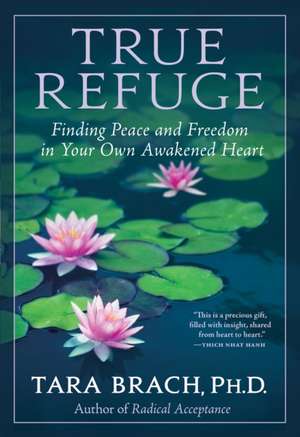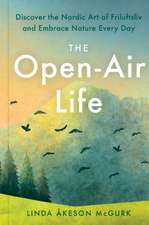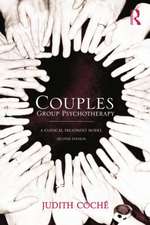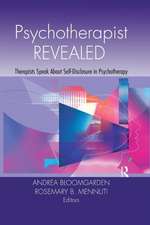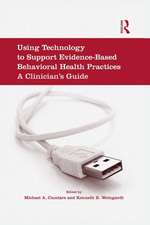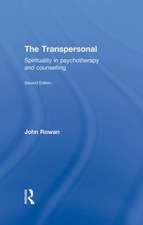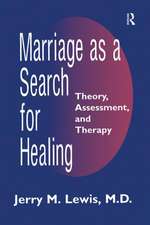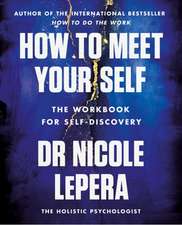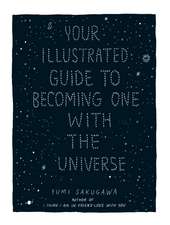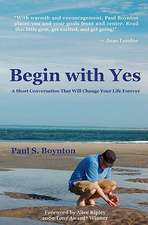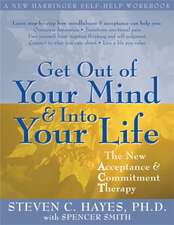True Refuge: Finding Peace and Freedom in Your Own Awakened Heart
Autor Tara Brachen Limba Engleză Paperback – 11 ian 2016
There is another way. Beneath the turbulence of our thoughts and emotions exists a profound stillness, a silent awareness capable of limitless love. Tara Brach, author of the award-winning Radical Acceptance, calls this awareness our true refuge, because it is available to every one of us, at any moment, no exceptions. In this book, Brach offers a practical guide to finding our inner sanctuary of peace and wisdom in the midst of difficulty.
Based on a fresh interpretation of the three classic Buddhist gateways to freedom—truth, love, and awareness—True Refuge shows us the way not just to heal our suffering, but also to cultivate our capacity for genuine happiness. Through spiritual teachings, guided meditations, and inspirational stories of people who discovered loving presence during times of great struggle, Brach invites us to connect more deeply with our own inner life, one another, and the world around us.
True Refuge is essential reading for anyone encountering hardship or crisis, anyone dedicated to a path of spiritual awakening. The book reminds us of our own innate intelligence and goodness, making possible an enduring trust in ourselves and our lives. We realize that what we seek is within us, and regardless of circumstances, “there is always a way to take refuge in a healing and liberating presence.”
Advance praise for True Refuge
“Drawing on the latest findings in neuroscience as well as ten more years of personal experience on the path of awakening, Tara Brach’s superb second book brings readers ever more deeply in touch with our true nature. This book is a precious gift, filled with insight, shared from heart to heart.”—Thich Nhat Hanh
“True Refuge is a magnificent work of heart. For anyone interested in developing a deeper understanding of the mind and how to improve the quality of their life, this book offers unique insights and easily learned practices that literally can transform your life’s path. Read, explore, and enjoy!”—Dan Siegel, author of Mindsight and The Whole-Brain Child
“This is a special book, lovely, loving, wise, and helpful. It is like having a sage and caring friend sit with you, offering comfort, insight, and guidance for your own true journey home.”—Jack Kornfield, author of The Wise Heart
“Tara Brach writes from the heart to the heart. With candor and calmness, she shares her own and others’ struggles to overcome our deep and constant human dilemmas. Whenever I read Brach, I feel more peaceful and hopeful. I trust myself and the universe more. I feel more connected and grounded in what the Lakota Sioux call Wakan Tanka, The Great Mystery. True Refuge is itself a refuge and I thank the author for it.”—Mary Pipher, Ph.D., New York Times bestselling author of The Green Boat and Reviving Ophelia
From the Hardcover edition.
| Toate formatele și edițiile | Preț | Express |
|---|---|---|
| Paperback (2) | 76.65 lei 3-4 săpt. | +28.65 lei 6-12 zile |
| Bantam – 11 ian 2016 | 91.87 lei 24 ore | |
| Hay House – 2 dec 2013 | 76.65 lei 3-4 săpt. | +28.65 lei 6-12 zile |
Preț: 91.87 lei
Preț vechi: 96.71 lei
-5% Nou
Puncte Express: 138
Preț estimativ în valută:
17.59€ • 18.35$ • 14.74£
17.59€ • 18.35$ • 14.74£
Carte în stoc
Livrare din stoc 31 ianuarie
Preluare comenzi: 021 569.72.76
Specificații
ISBN-13: 9780553386349
ISBN-10: 0553386344
Pagini: 320
Dimensiuni: 137 x 208 x 20 mm
Greutate: 0.25 kg
Editura: Bantam
ISBN-10: 0553386344
Pagini: 320
Dimensiuni: 137 x 208 x 20 mm
Greutate: 0.25 kg
Editura: Bantam
Notă biografică
Tara Brach, Ph.D., is the author of Radical Acceptance, winner of a Books for a Better Life Award. She is the founder of the Insight Meditation Community in Washington, D.C., and has conducted workshops across the country. She lives in Great Falls, Virginia, with her husband, her mother, and three dogs.
Extras
At the end of a daylong meditation workshop, Pam, a woman in her late sixties, drew me aside. She and her husband, Jerry, were at the end of an ordeal that had begun three years earlier. Now near death from lymphoma, Jerry had asked Pam to be his primary caregiver, the person guiding and supporting him in his passing. “Tara,” she implored, “I really need some help.”
Pam was desperate to do anything she could for her husband. “I wanted so much to save him,” she told me. “I looked into ayurvedic medicine, acupuncture, Chinese herbs, every alternative treatment I could find, tracked every test result . . . We were going to beat this thing.” She sat back wearily in her chair, shoulders slumped. “And now I’m keeping in touch with everyone, giving updates . . . coordinating hospice care. If he’s not napping I try to make him comfortable, read to him . . .”
I responded gently, “It sounds like you’ve been trying really hard to take good care of Jerry . . . and it’s been very busy.” At these words, she gave me a smile of recognition. “Hmm, busy. That sounds crazy, doesn’t it?” She paused. “As far back as I can remember I’ve really been busy . . . But now . . . well, I just can’t sit back and let him go without a fight.”
Pam was silent for a few moments and then she looked at me anxiously. “He could die any day now, Tara . . . Isn’t there some Buddhist practice or ritual that I should learn? Is there something I should be reading? What about The Tibetan Book of the Dead? How can I help him with this . . . with dying?”
Before answering, I asked her to listen inwardly, and to let me know what she was feeling. “I love him so much and I’m terrified that I’m going to let him down.” She began weeping. After some time, she spoke again. “All my life I’ve been afraid of falling short, I guess I’ve always been on overdrive trying to do a better job. Now I’m afraid I’m going to fail at the thing that matters most. He’ll die and I’ll feel really alone, because I failed him.”
“Pam,” I said, “you’ve already done so much . . . but the time for all that kind of activity is over. At this point, you don’t have to make anything happen, you don’t need to do anything.” I waited a moment and then added, “Just be with him. Let him know your love through the fullness of your presence.”
At this difficult time I was calling on a simple teaching that is central to my work with my meditation students and therapy clients: It is through realizing loving presence as our very essence, through being that presence, that we discover true freedom. In the face of inevitable loss, this timeless presence brings healing and peace to our own hearts and to the hearts of others.
Pam nodded. She and Jerry were Catholic, she told me, and the mindfulness practices they’d learned in my weekly class had helped them experience their faith more deeply. But Pam was now overwhelmed by Jerry’s dramatic turn for the worse: “I know the hospice aides are doing everything they can to help, but I just feel like this shouldn’t be happening—so much exhaustion, so much pain. No one should have to go through something like this; it’s just plain wrong.” For Pam, as for so many people, sickness felt unfair, an enemy to be resisted. She was face-to-face with dukkha, the suffering in life.
“In those most difficult moments,” I suggested, “you might pause and recognize what you are feeling—the fear or anger or grief—and then inwardly whisper the phrase ‘I consent.’ ” I’d recently heard this phrase from Father Thomas Keating, and thought that as a Catholic, Pam might find it particularly valuable. Saying “I consent,” or as I more frequently teach, “yes,” relaxes our armoring against the present moment and allows us to meet life’s challenges with a more open heart.
Pam was nodding her head, but she had an intent, worried look. “I want to do this, Tara, but when I’m most upset, my mind speeds up. I start talking to myself . . . I talk to him . . . How will I remember to pause?” It was a good question, one that I’m frequently asked. “You probably will forget, at least some of the time,” I responded, “and that’s totally natural. All you can do is have the intention to pause, the intention to feel what is going on and ‘let be.’ ” Pam’s face softened with understanding. “That I can do. I can intend, with all my heart, to be there for Jerry.”
Our Cry for Help
“All religions and spiritual traditions begin with the cry ‘Help!’,” wrote nineteenth-century American psychologist and philosopher William James. In my counseling sessions and meetings with meditation students, the cries for help I hear come in many forms. “How do I handle this clutching fear?” “This sense of failure, of unworthiness?” “This anguish of loss?”
As Pam was finding, no matter how hard we try to control life, we have no sway over the bedrock realities of change, loss, and mortality. Insecurity is inherent in this impermanent world. And so we pray for refuge: “Help! I want to feel protected and safe . . . loved and at peace. I want to belong to something larger than just myself. I want to feel at home in my life.”
Yet if we look honestly at our lives, it’s clear that we don’t often respond wisely to our own deep prayer. Rather than seeking true refuge, we turn toward what I call false refuges. They are false because while they may provide a temporary sense of comfort or security, they create more suffering in the long run. We might, like Pam, have a fear of failure and take refuge in staying busy, in striving to perform well, or in taking care of others. Or we might feel unlovable and take refuge in pursuing wealth or success. Maybe we fear being criticized, and take refuge in avoiding risks and always pleasing others. Or we feel anxious or empty and take refuge in alcohol, overeating, or surfing the Web. Instead of consenting and opening to what we are actually feeling, our turn toward false refuges is a way of avoiding emotional pain. But this only takes us further from real comfort, further from home.
As long as we pursue false refuges, suffering will pursue us. How many of us sleep fitfully, waking up in the middle of the night full of anxiety or dread? Or struggle to get through the day, too tense or restless to savor what’s going on right now? Instead of bringing us satisfaction or banishing our fear, our false refuges fuel a fundamental self-doubt. Pam had dedicated herself wholeheartedly to Jerry’s care. Yet nothing she did seemed like enough. Her anxious efforts to “do it right” reinforced her sense of insufficiency, of not being at home with who she was and what she could offer to Jerry.
Often it is not until we are jolted by crisis—a betrayal of the heart, the death of a loved one, our own impending death—that we see clearly: Our false refuges don’t work. They can’t save us from what we most fear, the pain of loss and separation. A crisis has the power to shatter our illusions, to reveal that in this impermanent world, there really is no ground to stand on, nothing we can hold on to. At these times, when our lives seem to be falling apart, the call for help can become fully conscious. This call is the heart’s longing for a refuge that is vast enough to embrace our most profound experience of suffering.
Coming Home to Loving Presence
A month after my conversation with Pam, she called to let me know that Jerry had died. Then she told me what had happened the evening after our talk. When she arrived back at their apartment, she had invited Jerry to join her in silent prayer. “When we were done,” she told me, “we shared our prayers. I let him know how much I wanted him to feel my love.” Pam was quiet for a moment, then her voice choked up. “He had been praying for the same . . . in reverse. We just hugged and cried.”
Even in those final weeks, Pam acknowledged, she had struggled with the urge to be busy, to find ways to feel useful. One afternoon, Jerry began talking about having only a short time left, and about not being afraid of death. She bent over, gave him a kiss, and said quickly, “Oh dear, today’s been a good day, you seemed to have more energy. Let me make you some herbal tea.” He fell silent, and the quietness shook her. “It became so clear to me in those moments that anything other than listening to what was really going on—anything other than being fully present—actually separated us. I hadn’t wanted us to admit to what was happening out loud; that just made it too real. So I avoided reality by suggesting a cup of tea. But my attempt to steer away from the truth took me away from him, and that was heartbreaking.”
While Pam boiled water for tea, she prayed, asking that her heart be fully present with Jerry. This prayer guided her in the days that followed. “Over those last few weeks I had to keep letting go of all my ideas of how his dying should be and what else I should be doing, and just remind myself to say ‘I consent.’ At first I was mechanically repeating the words, but after a few days I felt as if my heart actually started consenting.” She described how she would pause when she was gripped by strong feelings and check inside to see what was going on. When her gut tightened with clutches of fear and feelings of helplessness, she’d stay with those feelings, consenting to the depth of her vulnerability. When the restless urge to “do something” arose, she’d notice that and be still, letting it come and go. And as the great waves of grief rolled through, she’d again say, “I consent,” opening herself to the huge aching weight of loss.
This intimate presence with her inner experience allowed Pam to fully attend to Jerry. As she put it, “When all of me was truly consenting to the fear and pain, I knew how to take care of him. I sensed when to whisper words of encouragement or just listen, ways to reassure him with touch . . . how to sing to him, be quiet with him. How to be with him.”
Before she ended the call, Pam shared with me what she considered to be the gift of her last days with Jerry, the answer to her prayers: “In the silence I could see past a sense of ‘him’ and ‘me.’ It became clear that we were a field of loving—total openness, warmth, light. He’s gone, but that field of loving is always with me. My heart knows that I came home . . . truly I came home to love.”
Learning to Trust the Waves
Pam’s willingness to be present with her inner life, no matter how painful, made it possible for her to connect with the vastness of love. Her growing capacity for presence, for staying with the truth of her moment-to-moment experience, enabled her to find her way home even in the midst of great loss. Presence is the essence of true refuge.
A different kind of loss drew me to my first Buddhist mindfulness retreat. At the time, my son, Narayan, was four and I was on the verge of divorce. I had already benefited from Buddhist meditation, and I hoped that a period of intensive practice would help me navigate my anxiety and stress. After leaving Narayan with my parents in New Jersey, I drove through a winter snowstorm to the retreat center in Massachusetts. During that slow, icy drive, I had plenty of time to reflect on what most mattered to me. I didn’t want a breakup that would bury the love I still shared with my husband; I didn’t want us to turn into uncaring, even hostile, strangers. And I didn’t want a breakup that would deprive Narayan of feeling secure and loved. My deep prayer was that through all that was happening, I’d find a way to stay connected with my heart.
Over the next five days, through hours of silent meditation, I cycled many times through periods of clarity and attentiveness, followed by stretches when I was swamped in sleepiness, plagued by physical discomfort, or lost in a wandering mind. Early one evening I became inundated by thoughts about the upcoming months: Should my husband and I hire lawyers or a mediator to handle the process of divorce? When should we move to separate residences? And, most important, how should I be there for our son during this painful transition? As each anxious thought surfaced, I wanted to really dig in and work everything out in my mind. Yet something in me knew I needed to stay with the unpleasant feelings in my body. A verse from Ryokan, an eighteenth-century Zen poet, came to mind: “To find the Buddhist law, drift east and west, come and go, entrusting yourself to the waves.”
The “Buddhist law” refers to the truth of how things really are. We can’t understand the nature of reality until we let go of controlling our experience. There’s no way to see clearly what is going on if on some level we are attempting to ignore or bypass the stormy weather. During the last few days of the retreat I tried to let go over and over, but felt repeatedly stymied by my well-worn strategy for feeling better—figuring things out. Now Ryokan’s verse was rife with possibility: Perhaps I could entrust myself to the waves. Perhaps the only way to real peace was by opening to life just as it was. Otherwise, behind my efforts to manage things, I’d always sense a lurking threat, something right around the corner that was going to cause trouble.
I tried to open to the waves of feeling, but my old habits didn’t give up easily. I’d contact some tightness in my chest, but flip right back into worrying about my son’s new preschool, about carpooling, about how to find a babysitter with more flexible hours. Then I’d become hypercritical, harshly judging myself for “wasting” my retreat time. Gradually, I recognized that my heart was clenched tight, afraid to let the intensity of life wash through me. I needed help in “entrusting.”
The teachers had been leading the whole group in a lovingkindness meditation each afternoon, and I decided to try weaving this practice into my sitting. The classical form of the meditation consists of sending loving prayers to ourselves and to widening circles of other beings. I began to offer kind wishes to myself: “May I be happy and at ease; may I be happy and at ease.” At first, repeating the words felt like a superficial mental exercise, but soon something shifted. My heart meant it: I cared about my own life, and becoming conscious of that caring softened some of the tightness around my heart.
Now I could more easily give myself to the waves of fear and sorrow, and simply notice the drifting thoughts and physical sensations—squeezing and soreness—that were coming and going. Whenever the worries that had been snagging me appeared, I sensed that they too were waves, tenacious ones that pressed uncomfortably on my chest. By not resisting, by letting the waves wash through me, I began to relax. Rather than fighting the stormy surges, I rested in an ocean of awareness that embraced all the moving waves. I had arrived in a sanctuary that felt large enough to hold whatever was going on in my life.
Natural Presence: Wakeful, Open, and Tender
Presence is not some exotic state that we need to search for or manufacture. In the simplest terms, it is the felt sense of wakefulness, openness, and tenderness that arises when we are fully here and now with our experience. You’ve surely tasted presence, even if you didn’t call it that. Perhaps you’ve felt it lying awake in bed and listening to crickets on a hot summer night. You might have sensed presence while walking alone in the woods. You might have arrived in full presence as you witnessed someone dying or being born.
Presence is the awareness that is intrinsic to our nature. It is immediate and embodied, perceived through our senses. If you look closely at any experience of presence, you’ll find the three qualities I mentioned above:
Our wakefulness is the basic consciousness that is aware of what is happening, the intelligence that recognizes the changing flow of moment-by-moment experience—the sounds that are here around us, the sensations of our body, our thoughts. It is the “knowing” quality of awareness.
Our openness is the space of awareness in which life takes place. This awareness does not oppose our experience, or evaluate it in any way. Even when our feelings and thoughts are painfully stirred up, it simply recognizes what’s happening and allows our emotional life to be as it is. Like the sky when weather systems come and go, the open space of awareness is unstained by the changing expressions of life moving through us. And yet awareness has a natural sensitivity and the capacity to express warmth. This responsiveness is what I call tenderness. Our tenderness allows us to respond with compassion, love, and awe to whatever arises, in all its beauty and sorrow.
We can refer to these as the three qualities of presence, but in fact they’re inseparable. Think of a sunlit sky. There is no way to separate the light of the sky from the space it illuminates; there is no way to separate the warmth we feel from the space and light around us. Light, space, and warmth are all inextricable expressions of a whole.
Our longing to live fully—from our beingness—calls us home to this natural presence. Our realization of truth arises from the lucidity of presence. Love flows from the receptivity of presence. Aliveness and creativity flower when we inhabit the openness of presence. All that we cherish is already here, sourced in presence. Each time we cry out for help, our longing can remind us to turn toward our true refuge, toward the healing and freedom of natural presence.
Coming Back to Presence
After my retreat, I returned home with the intention of taking refuge in presence whenever I was irritated, anxious, and tight. I was alert when the first flare-up occurred, a week after I got back. My ex-husband called to say he couldn’t take care of Narayan that evening, leaving me scrambling to find a babysitter so I could see my therapy clients. “I’m the breadwinner, and I can’t even count on him for this!” my mind sputtered. “Once again he’s not doing his share, once again he’s letting me down!” But when I was done for the day I took some time to pause and touch into the judgment and blame lingering in my body, and my righteous stance softened. I sat still as the blaming thoughts and swells of irritation came and went. Underneath the resentment was an anxious question: “How will I manage?” As I let the subterranean waves of anxiety move through me, I found a quiet inner space that had more breathing room—and more perspective. Of course I couldn’t figure out how the future would play out. The only time I had was right now, and this moment was okay. From this space I could sense my ex-husband’s stress about finding a new place to live, working out our schedules, and more deeply, adapting to a different future than he had imagined. This helped me feel more tolerant and kind.
At other times I was much more resistant to entrusting myself to the waves, especially when my ex and I disagreed on finances or on the particulars of our custody arrangement. Any kind of entrusting felt like a setup for getting taken advantage of. I found that I first needed to hold myself with compassion, really honoring my need to take care of myself. Then I could regard even my most angry, mean-spirited thoughts with forgiveness. Gradually my heart would unclench some and I’d allow myself to simply feel the painful currents of anger and fear moving through me. Then, as I’d experienced at the retreat, I’d reconnect with a spacious presence that included whatever was happening, and it allowed me to regard my life with more wisdom. Resting in this presence, I could begin to more clearly distinguish my own healthy needs—for separating out our finances fairly, for having our own living spaces—from my anxious and distrustful impulses. I felt at home in myself when I stood up for what I needed, but not when I tried to exert a tightfisted control. And, as I discovered, the more my ex-husband sensed me trying to be respectful and flexible, the more he responded in kind.
Taking refuge in presence made it possible for me and my ex-husband to continue to be dear friends and to still consider each other family. But it wasn’t easy. Both of us were dedicated to spiritual practice, so we entered the separation process naively, believing that we could navigate it in an honorable, mature way. Neither of us anticipated that when we were really stressed, we’d purposefully act in hurtful ways. Yet at times we did—we misled each other, we said things we regretted, we sometimes exuded anger or disdain. What carried us through this emotionally painful season was a commitment to keep our son’s best interests in the foreground, and not to give up on loving each other. The practice of taking refuge in presence allowed me to forgive both of us for our humanness and helped to keep our caring alive.
When we are suffering, our call of “Help!” can arise from a deep place within us. As Pam found at Jerry’s side, and as I experienced at the end of my first marriage, our sincere longing awakens us. It guides us to the wholeness and freedom that can be found in the present moment. And yet, when we’re in trouble, here and now is often the last place we want to be. What stops us from coming home to the true refuge of presence? What stops us from choosing to be here? My name for this challenge to presence is “the trance of small self,” and we will explore it in the following chapter.
Guided Meditation: A Pause for Presence
A natural entry into presence is through your body. You can do this short meditation anytime you have a bit of quiet and privacy.
R
Find a place to sit comfortably and close your eyes. Begin with three conscious breaths: Inhale long and deep, filling the lungs, then exhale slowly, sensing a letting go of any tensions in your body and mind.
Invite your awareness to fill your whole body. Can you imagine your physical form as a field of sensations? Can you feel the movement and quality of the sensations—tingling, vibrating, heat or cool, hard or soft, tight or flowing? Take a few moments to bring your full attention to this dance of sensations.
Now let your awareness open out into the space around you. Can you imagine receiving the symphony of sounds, letting it wash through you? Can you listen to the changing play of sounds, not just with your ears but with your whole awareness? Take a few moments to bring an open attention to listening to sounds.
Keeping your eyes closed, let your awareness receive the play of images and light at the eyelids. You might notice a flickering of light and dark or certain shapes, shadows or figures of light. Take a few moments to attend to seeing.
Feeling your breath and sensing the space around you, be receptive to any scents that might be in the air. Discover what it is like to smell and receive the odors present in the surrounding area.
Now let all your senses be wide open, your body and mind relaxed and receptive. Allow life to flow freely through you. Take as long as you’d like, listening to and feeling your moment-to-moment experience. Notice the changing flow of sensations, sounds, aliveness, and also the background of presence that is here. Let yourself appreciate this awake, inner space of presence. When you are finished, sense the possibility of bringing an alert, open awareness to whatever you are doing next.
R
As you move through the day, pause periodically and briefly reawaken your senses, primarily by feeling bodily sensations and listening to sounds. With practice, you will become increasingly at home in natural presence.
Pam was desperate to do anything she could for her husband. “I wanted so much to save him,” she told me. “I looked into ayurvedic medicine, acupuncture, Chinese herbs, every alternative treatment I could find, tracked every test result . . . We were going to beat this thing.” She sat back wearily in her chair, shoulders slumped. “And now I’m keeping in touch with everyone, giving updates . . . coordinating hospice care. If he’s not napping I try to make him comfortable, read to him . . .”
I responded gently, “It sounds like you’ve been trying really hard to take good care of Jerry . . . and it’s been very busy.” At these words, she gave me a smile of recognition. “Hmm, busy. That sounds crazy, doesn’t it?” She paused. “As far back as I can remember I’ve really been busy . . . But now . . . well, I just can’t sit back and let him go without a fight.”
Pam was silent for a few moments and then she looked at me anxiously. “He could die any day now, Tara . . . Isn’t there some Buddhist practice or ritual that I should learn? Is there something I should be reading? What about The Tibetan Book of the Dead? How can I help him with this . . . with dying?”
Before answering, I asked her to listen inwardly, and to let me know what she was feeling. “I love him so much and I’m terrified that I’m going to let him down.” She began weeping. After some time, she spoke again. “All my life I’ve been afraid of falling short, I guess I’ve always been on overdrive trying to do a better job. Now I’m afraid I’m going to fail at the thing that matters most. He’ll die and I’ll feel really alone, because I failed him.”
“Pam,” I said, “you’ve already done so much . . . but the time for all that kind of activity is over. At this point, you don’t have to make anything happen, you don’t need to do anything.” I waited a moment and then added, “Just be with him. Let him know your love through the fullness of your presence.”
At this difficult time I was calling on a simple teaching that is central to my work with my meditation students and therapy clients: It is through realizing loving presence as our very essence, through being that presence, that we discover true freedom. In the face of inevitable loss, this timeless presence brings healing and peace to our own hearts and to the hearts of others.
Pam nodded. She and Jerry were Catholic, she told me, and the mindfulness practices they’d learned in my weekly class had helped them experience their faith more deeply. But Pam was now overwhelmed by Jerry’s dramatic turn for the worse: “I know the hospice aides are doing everything they can to help, but I just feel like this shouldn’t be happening—so much exhaustion, so much pain. No one should have to go through something like this; it’s just plain wrong.” For Pam, as for so many people, sickness felt unfair, an enemy to be resisted. She was face-to-face with dukkha, the suffering in life.
“In those most difficult moments,” I suggested, “you might pause and recognize what you are feeling—the fear or anger or grief—and then inwardly whisper the phrase ‘I consent.’ ” I’d recently heard this phrase from Father Thomas Keating, and thought that as a Catholic, Pam might find it particularly valuable. Saying “I consent,” or as I more frequently teach, “yes,” relaxes our armoring against the present moment and allows us to meet life’s challenges with a more open heart.
Pam was nodding her head, but she had an intent, worried look. “I want to do this, Tara, but when I’m most upset, my mind speeds up. I start talking to myself . . . I talk to him . . . How will I remember to pause?” It was a good question, one that I’m frequently asked. “You probably will forget, at least some of the time,” I responded, “and that’s totally natural. All you can do is have the intention to pause, the intention to feel what is going on and ‘let be.’ ” Pam’s face softened with understanding. “That I can do. I can intend, with all my heart, to be there for Jerry.”
Our Cry for Help
“All religions and spiritual traditions begin with the cry ‘Help!’,” wrote nineteenth-century American psychologist and philosopher William James. In my counseling sessions and meetings with meditation students, the cries for help I hear come in many forms. “How do I handle this clutching fear?” “This sense of failure, of unworthiness?” “This anguish of loss?”
As Pam was finding, no matter how hard we try to control life, we have no sway over the bedrock realities of change, loss, and mortality. Insecurity is inherent in this impermanent world. And so we pray for refuge: “Help! I want to feel protected and safe . . . loved and at peace. I want to belong to something larger than just myself. I want to feel at home in my life.”
Yet if we look honestly at our lives, it’s clear that we don’t often respond wisely to our own deep prayer. Rather than seeking true refuge, we turn toward what I call false refuges. They are false because while they may provide a temporary sense of comfort or security, they create more suffering in the long run. We might, like Pam, have a fear of failure and take refuge in staying busy, in striving to perform well, or in taking care of others. Or we might feel unlovable and take refuge in pursuing wealth or success. Maybe we fear being criticized, and take refuge in avoiding risks and always pleasing others. Or we feel anxious or empty and take refuge in alcohol, overeating, or surfing the Web. Instead of consenting and opening to what we are actually feeling, our turn toward false refuges is a way of avoiding emotional pain. But this only takes us further from real comfort, further from home.
As long as we pursue false refuges, suffering will pursue us. How many of us sleep fitfully, waking up in the middle of the night full of anxiety or dread? Or struggle to get through the day, too tense or restless to savor what’s going on right now? Instead of bringing us satisfaction or banishing our fear, our false refuges fuel a fundamental self-doubt. Pam had dedicated herself wholeheartedly to Jerry’s care. Yet nothing she did seemed like enough. Her anxious efforts to “do it right” reinforced her sense of insufficiency, of not being at home with who she was and what she could offer to Jerry.
Often it is not until we are jolted by crisis—a betrayal of the heart, the death of a loved one, our own impending death—that we see clearly: Our false refuges don’t work. They can’t save us from what we most fear, the pain of loss and separation. A crisis has the power to shatter our illusions, to reveal that in this impermanent world, there really is no ground to stand on, nothing we can hold on to. At these times, when our lives seem to be falling apart, the call for help can become fully conscious. This call is the heart’s longing for a refuge that is vast enough to embrace our most profound experience of suffering.
Coming Home to Loving Presence
A month after my conversation with Pam, she called to let me know that Jerry had died. Then she told me what had happened the evening after our talk. When she arrived back at their apartment, she had invited Jerry to join her in silent prayer. “When we were done,” she told me, “we shared our prayers. I let him know how much I wanted him to feel my love.” Pam was quiet for a moment, then her voice choked up. “He had been praying for the same . . . in reverse. We just hugged and cried.”
Even in those final weeks, Pam acknowledged, she had struggled with the urge to be busy, to find ways to feel useful. One afternoon, Jerry began talking about having only a short time left, and about not being afraid of death. She bent over, gave him a kiss, and said quickly, “Oh dear, today’s been a good day, you seemed to have more energy. Let me make you some herbal tea.” He fell silent, and the quietness shook her. “It became so clear to me in those moments that anything other than listening to what was really going on—anything other than being fully present—actually separated us. I hadn’t wanted us to admit to what was happening out loud; that just made it too real. So I avoided reality by suggesting a cup of tea. But my attempt to steer away from the truth took me away from him, and that was heartbreaking.”
While Pam boiled water for tea, she prayed, asking that her heart be fully present with Jerry. This prayer guided her in the days that followed. “Over those last few weeks I had to keep letting go of all my ideas of how his dying should be and what else I should be doing, and just remind myself to say ‘I consent.’ At first I was mechanically repeating the words, but after a few days I felt as if my heart actually started consenting.” She described how she would pause when she was gripped by strong feelings and check inside to see what was going on. When her gut tightened with clutches of fear and feelings of helplessness, she’d stay with those feelings, consenting to the depth of her vulnerability. When the restless urge to “do something” arose, she’d notice that and be still, letting it come and go. And as the great waves of grief rolled through, she’d again say, “I consent,” opening herself to the huge aching weight of loss.
This intimate presence with her inner experience allowed Pam to fully attend to Jerry. As she put it, “When all of me was truly consenting to the fear and pain, I knew how to take care of him. I sensed when to whisper words of encouragement or just listen, ways to reassure him with touch . . . how to sing to him, be quiet with him. How to be with him.”
Before she ended the call, Pam shared with me what she considered to be the gift of her last days with Jerry, the answer to her prayers: “In the silence I could see past a sense of ‘him’ and ‘me.’ It became clear that we were a field of loving—total openness, warmth, light. He’s gone, but that field of loving is always with me. My heart knows that I came home . . . truly I came home to love.”
Learning to Trust the Waves
Pam’s willingness to be present with her inner life, no matter how painful, made it possible for her to connect with the vastness of love. Her growing capacity for presence, for staying with the truth of her moment-to-moment experience, enabled her to find her way home even in the midst of great loss. Presence is the essence of true refuge.
A different kind of loss drew me to my first Buddhist mindfulness retreat. At the time, my son, Narayan, was four and I was on the verge of divorce. I had already benefited from Buddhist meditation, and I hoped that a period of intensive practice would help me navigate my anxiety and stress. After leaving Narayan with my parents in New Jersey, I drove through a winter snowstorm to the retreat center in Massachusetts. During that slow, icy drive, I had plenty of time to reflect on what most mattered to me. I didn’t want a breakup that would bury the love I still shared with my husband; I didn’t want us to turn into uncaring, even hostile, strangers. And I didn’t want a breakup that would deprive Narayan of feeling secure and loved. My deep prayer was that through all that was happening, I’d find a way to stay connected with my heart.
Over the next five days, through hours of silent meditation, I cycled many times through periods of clarity and attentiveness, followed by stretches when I was swamped in sleepiness, plagued by physical discomfort, or lost in a wandering mind. Early one evening I became inundated by thoughts about the upcoming months: Should my husband and I hire lawyers or a mediator to handle the process of divorce? When should we move to separate residences? And, most important, how should I be there for our son during this painful transition? As each anxious thought surfaced, I wanted to really dig in and work everything out in my mind. Yet something in me knew I needed to stay with the unpleasant feelings in my body. A verse from Ryokan, an eighteenth-century Zen poet, came to mind: “To find the Buddhist law, drift east and west, come and go, entrusting yourself to the waves.”
The “Buddhist law” refers to the truth of how things really are. We can’t understand the nature of reality until we let go of controlling our experience. There’s no way to see clearly what is going on if on some level we are attempting to ignore or bypass the stormy weather. During the last few days of the retreat I tried to let go over and over, but felt repeatedly stymied by my well-worn strategy for feeling better—figuring things out. Now Ryokan’s verse was rife with possibility: Perhaps I could entrust myself to the waves. Perhaps the only way to real peace was by opening to life just as it was. Otherwise, behind my efforts to manage things, I’d always sense a lurking threat, something right around the corner that was going to cause trouble.
I tried to open to the waves of feeling, but my old habits didn’t give up easily. I’d contact some tightness in my chest, but flip right back into worrying about my son’s new preschool, about carpooling, about how to find a babysitter with more flexible hours. Then I’d become hypercritical, harshly judging myself for “wasting” my retreat time. Gradually, I recognized that my heart was clenched tight, afraid to let the intensity of life wash through me. I needed help in “entrusting.”
The teachers had been leading the whole group in a lovingkindness meditation each afternoon, and I decided to try weaving this practice into my sitting. The classical form of the meditation consists of sending loving prayers to ourselves and to widening circles of other beings. I began to offer kind wishes to myself: “May I be happy and at ease; may I be happy and at ease.” At first, repeating the words felt like a superficial mental exercise, but soon something shifted. My heart meant it: I cared about my own life, and becoming conscious of that caring softened some of the tightness around my heart.
Now I could more easily give myself to the waves of fear and sorrow, and simply notice the drifting thoughts and physical sensations—squeezing and soreness—that were coming and going. Whenever the worries that had been snagging me appeared, I sensed that they too were waves, tenacious ones that pressed uncomfortably on my chest. By not resisting, by letting the waves wash through me, I began to relax. Rather than fighting the stormy surges, I rested in an ocean of awareness that embraced all the moving waves. I had arrived in a sanctuary that felt large enough to hold whatever was going on in my life.
Natural Presence: Wakeful, Open, and Tender
Presence is not some exotic state that we need to search for or manufacture. In the simplest terms, it is the felt sense of wakefulness, openness, and tenderness that arises when we are fully here and now with our experience. You’ve surely tasted presence, even if you didn’t call it that. Perhaps you’ve felt it lying awake in bed and listening to crickets on a hot summer night. You might have sensed presence while walking alone in the woods. You might have arrived in full presence as you witnessed someone dying or being born.
Presence is the awareness that is intrinsic to our nature. It is immediate and embodied, perceived through our senses. If you look closely at any experience of presence, you’ll find the three qualities I mentioned above:
Our wakefulness is the basic consciousness that is aware of what is happening, the intelligence that recognizes the changing flow of moment-by-moment experience—the sounds that are here around us, the sensations of our body, our thoughts. It is the “knowing” quality of awareness.
Our openness is the space of awareness in which life takes place. This awareness does not oppose our experience, or evaluate it in any way. Even when our feelings and thoughts are painfully stirred up, it simply recognizes what’s happening and allows our emotional life to be as it is. Like the sky when weather systems come and go, the open space of awareness is unstained by the changing expressions of life moving through us. And yet awareness has a natural sensitivity and the capacity to express warmth. This responsiveness is what I call tenderness. Our tenderness allows us to respond with compassion, love, and awe to whatever arises, in all its beauty and sorrow.
We can refer to these as the three qualities of presence, but in fact they’re inseparable. Think of a sunlit sky. There is no way to separate the light of the sky from the space it illuminates; there is no way to separate the warmth we feel from the space and light around us. Light, space, and warmth are all inextricable expressions of a whole.
Our longing to live fully—from our beingness—calls us home to this natural presence. Our realization of truth arises from the lucidity of presence. Love flows from the receptivity of presence. Aliveness and creativity flower when we inhabit the openness of presence. All that we cherish is already here, sourced in presence. Each time we cry out for help, our longing can remind us to turn toward our true refuge, toward the healing and freedom of natural presence.
Coming Back to Presence
After my retreat, I returned home with the intention of taking refuge in presence whenever I was irritated, anxious, and tight. I was alert when the first flare-up occurred, a week after I got back. My ex-husband called to say he couldn’t take care of Narayan that evening, leaving me scrambling to find a babysitter so I could see my therapy clients. “I’m the breadwinner, and I can’t even count on him for this!” my mind sputtered. “Once again he’s not doing his share, once again he’s letting me down!” But when I was done for the day I took some time to pause and touch into the judgment and blame lingering in my body, and my righteous stance softened. I sat still as the blaming thoughts and swells of irritation came and went. Underneath the resentment was an anxious question: “How will I manage?” As I let the subterranean waves of anxiety move through me, I found a quiet inner space that had more breathing room—and more perspective. Of course I couldn’t figure out how the future would play out. The only time I had was right now, and this moment was okay. From this space I could sense my ex-husband’s stress about finding a new place to live, working out our schedules, and more deeply, adapting to a different future than he had imagined. This helped me feel more tolerant and kind.
At other times I was much more resistant to entrusting myself to the waves, especially when my ex and I disagreed on finances or on the particulars of our custody arrangement. Any kind of entrusting felt like a setup for getting taken advantage of. I found that I first needed to hold myself with compassion, really honoring my need to take care of myself. Then I could regard even my most angry, mean-spirited thoughts with forgiveness. Gradually my heart would unclench some and I’d allow myself to simply feel the painful currents of anger and fear moving through me. Then, as I’d experienced at the retreat, I’d reconnect with a spacious presence that included whatever was happening, and it allowed me to regard my life with more wisdom. Resting in this presence, I could begin to more clearly distinguish my own healthy needs—for separating out our finances fairly, for having our own living spaces—from my anxious and distrustful impulses. I felt at home in myself when I stood up for what I needed, but not when I tried to exert a tightfisted control. And, as I discovered, the more my ex-husband sensed me trying to be respectful and flexible, the more he responded in kind.
Taking refuge in presence made it possible for me and my ex-husband to continue to be dear friends and to still consider each other family. But it wasn’t easy. Both of us were dedicated to spiritual practice, so we entered the separation process naively, believing that we could navigate it in an honorable, mature way. Neither of us anticipated that when we were really stressed, we’d purposefully act in hurtful ways. Yet at times we did—we misled each other, we said things we regretted, we sometimes exuded anger or disdain. What carried us through this emotionally painful season was a commitment to keep our son’s best interests in the foreground, and not to give up on loving each other. The practice of taking refuge in presence allowed me to forgive both of us for our humanness and helped to keep our caring alive.
When we are suffering, our call of “Help!” can arise from a deep place within us. As Pam found at Jerry’s side, and as I experienced at the end of my first marriage, our sincere longing awakens us. It guides us to the wholeness and freedom that can be found in the present moment. And yet, when we’re in trouble, here and now is often the last place we want to be. What stops us from coming home to the true refuge of presence? What stops us from choosing to be here? My name for this challenge to presence is “the trance of small self,” and we will explore it in the following chapter.
Guided Meditation: A Pause for Presence
A natural entry into presence is through your body. You can do this short meditation anytime you have a bit of quiet and privacy.
R
Find a place to sit comfortably and close your eyes. Begin with three conscious breaths: Inhale long and deep, filling the lungs, then exhale slowly, sensing a letting go of any tensions in your body and mind.
Invite your awareness to fill your whole body. Can you imagine your physical form as a field of sensations? Can you feel the movement and quality of the sensations—tingling, vibrating, heat or cool, hard or soft, tight or flowing? Take a few moments to bring your full attention to this dance of sensations.
Now let your awareness open out into the space around you. Can you imagine receiving the symphony of sounds, letting it wash through you? Can you listen to the changing play of sounds, not just with your ears but with your whole awareness? Take a few moments to bring an open attention to listening to sounds.
Keeping your eyes closed, let your awareness receive the play of images and light at the eyelids. You might notice a flickering of light and dark or certain shapes, shadows or figures of light. Take a few moments to attend to seeing.
Feeling your breath and sensing the space around you, be receptive to any scents that might be in the air. Discover what it is like to smell and receive the odors present in the surrounding area.
Now let all your senses be wide open, your body and mind relaxed and receptive. Allow life to flow freely through you. Take as long as you’d like, listening to and feeling your moment-to-moment experience. Notice the changing flow of sensations, sounds, aliveness, and also the background of presence that is here. Let yourself appreciate this awake, inner space of presence. When you are finished, sense the possibility of bringing an alert, open awareness to whatever you are doing next.
R
As you move through the day, pause periodically and briefly reawaken your senses, primarily by feeling bodily sensations and listening to sounds. With practice, you will become increasingly at home in natural presence.
Recenzii
Advance praise for True Refuge
“Drawing on the latest findings in neuroscience as well as ten more years of personal experience on the path of awakening, Tara Brach’s superb second book brings readers ever more deeply in touch with our true nature. This book is a precious gift, filled with insight, shared from heart to heart.”—Thich Nhat Hanh
“True Refuge is a magnificent work of heart. For anyone interested in developing a deeper understanding of the mind and how to improve the quality of their life, this book offers unique insights and easily learned practices that literally can transform your life’s path. Read, explore, and enjoy!”—Dan Siegel, author of Mindsight and The Whole-Brain Child
“This is a special book, lovely, loving, wise, and helpful. It is like having a sage and caring friend sit with you, offering comfort, insight, and guidance for your own true journey home.”—Jack Kornfield, author of The Wise Heart
“Tara Brach writes from the heart to the heart. With candor and calmness, she shares her own and others’ struggles to overcome our deep and constant human dilemmas. Whenever I read Brach, I feel more peaceful and hopeful. I trust myself and the universe more. I feel more connected and grounded in what the Lakota Sioux call Wakan Tanka, The Great Mystery. True Refuge is itself a refuge and I thank the author for it.”—Mary Pipher, Ph.D., New York Times bestselling author of The Green Boat and Reviving Ophelia
“Tara Brach has done it again. True Refuge inspires the confidence needed to face our deepest, most difficult emotions. With tenderness and understanding, she teaches us the practical techniques that can help us loosen the grip of these emotions and arrive at a place of peace and basic goodness which is our essential nature. As more and more citizens learn and practice these techniques, it can begin a transformation that will allow a kinder, compassionate, and more mindful nation to emerge.”—Congressman Tim Ryan, author of A Mindful Nation
“There is something very special about this exquisitely written book—its clarity, beauty, simplicity, and humanity practically sing to you. Inspiring and uplifting to read, it also has eminently practical, implementable, step-by-step guidance to practice and live by. And the fifteen brief, powerful guided meditations offer an easy, gentle entry toward inner peace and wisdom. While turning the pages, I thought of a half dozen people who could really use this book as a friendly, loving reference point—myself included!”—Belleruth Naparstek, author of Invisible Heroes and creator of the Health Journeys guided imagery audio series
“This is a beautifully written book that directly taps into the beating heart of wisdom and compassion. It offers useful, pragmatic advice on how to deepen one’s mindfulness practice and have greater self-compassion when faced with suffering. A wonderful follow-up to Radical Acceptance, this is a must-read for anyone who wants to develop greater insight and open-heartedness in their life.”—Kristin Neff, Ph.D., author of Self-Compassion
“This book is a rare gift. It speaks to the tender heart in us all when things go wrong in our lives. In a natural and deeply personal way, Tara Brach accompanies the reader into “presence,” a warm embrace of who we are and the life we’re given. She offers tools and gentle guidance for living safely and peacefully even in the midst of challenging circumstances. At once inspiring, humble, and wise, this book uniquely captures the ineffable, healing essence of mindfulness meditation practice.”
ߝChristopher Germer, Ph.D., Clinical Instructor, Harvard Medical School, author of The Mindful Path to Self-Compassion
From the Hardcover edition.
“Drawing on the latest findings in neuroscience as well as ten more years of personal experience on the path of awakening, Tara Brach’s superb second book brings readers ever more deeply in touch with our true nature. This book is a precious gift, filled with insight, shared from heart to heart.”—Thich Nhat Hanh
“True Refuge is a magnificent work of heart. For anyone interested in developing a deeper understanding of the mind and how to improve the quality of their life, this book offers unique insights and easily learned practices that literally can transform your life’s path. Read, explore, and enjoy!”—Dan Siegel, author of Mindsight and The Whole-Brain Child
“This is a special book, lovely, loving, wise, and helpful. It is like having a sage and caring friend sit with you, offering comfort, insight, and guidance for your own true journey home.”—Jack Kornfield, author of The Wise Heart
“Tara Brach writes from the heart to the heart. With candor and calmness, she shares her own and others’ struggles to overcome our deep and constant human dilemmas. Whenever I read Brach, I feel more peaceful and hopeful. I trust myself and the universe more. I feel more connected and grounded in what the Lakota Sioux call Wakan Tanka, The Great Mystery. True Refuge is itself a refuge and I thank the author for it.”—Mary Pipher, Ph.D., New York Times bestselling author of The Green Boat and Reviving Ophelia
“Tara Brach has done it again. True Refuge inspires the confidence needed to face our deepest, most difficult emotions. With tenderness and understanding, she teaches us the practical techniques that can help us loosen the grip of these emotions and arrive at a place of peace and basic goodness which is our essential nature. As more and more citizens learn and practice these techniques, it can begin a transformation that will allow a kinder, compassionate, and more mindful nation to emerge.”—Congressman Tim Ryan, author of A Mindful Nation
“There is something very special about this exquisitely written book—its clarity, beauty, simplicity, and humanity practically sing to you. Inspiring and uplifting to read, it also has eminently practical, implementable, step-by-step guidance to practice and live by. And the fifteen brief, powerful guided meditations offer an easy, gentle entry toward inner peace and wisdom. While turning the pages, I thought of a half dozen people who could really use this book as a friendly, loving reference point—myself included!”—Belleruth Naparstek, author of Invisible Heroes and creator of the Health Journeys guided imagery audio series
“This is a beautifully written book that directly taps into the beating heart of wisdom and compassion. It offers useful, pragmatic advice on how to deepen one’s mindfulness practice and have greater self-compassion when faced with suffering. A wonderful follow-up to Radical Acceptance, this is a must-read for anyone who wants to develop greater insight and open-heartedness in their life.”—Kristin Neff, Ph.D., author of Self-Compassion
“This book is a rare gift. It speaks to the tender heart in us all when things go wrong in our lives. In a natural and deeply personal way, Tara Brach accompanies the reader into “presence,” a warm embrace of who we are and the life we’re given. She offers tools and gentle guidance for living safely and peacefully even in the midst of challenging circumstances. At once inspiring, humble, and wise, this book uniquely captures the ineffable, healing essence of mindfulness meditation practice.”
ߝChristopher Germer, Ph.D., Clinical Instructor, Harvard Medical School, author of The Mindful Path to Self-Compassion
From the Hardcover edition.
Descriere
Descriere de la o altă ediție sau format:
How do you cope when facing life-threatening illness, family conflict, faltering relationships, old trauma, obsessive thinking, overwhelming emotion or inevitable loss? This book offers a practical guide to finding our inner sanctuary of peace and wisdom in the midst of difficulty.
How do you cope when facing life-threatening illness, family conflict, faltering relationships, old trauma, obsessive thinking, overwhelming emotion or inevitable loss? This book offers a practical guide to finding our inner sanctuary of peace and wisdom in the midst of difficulty.
